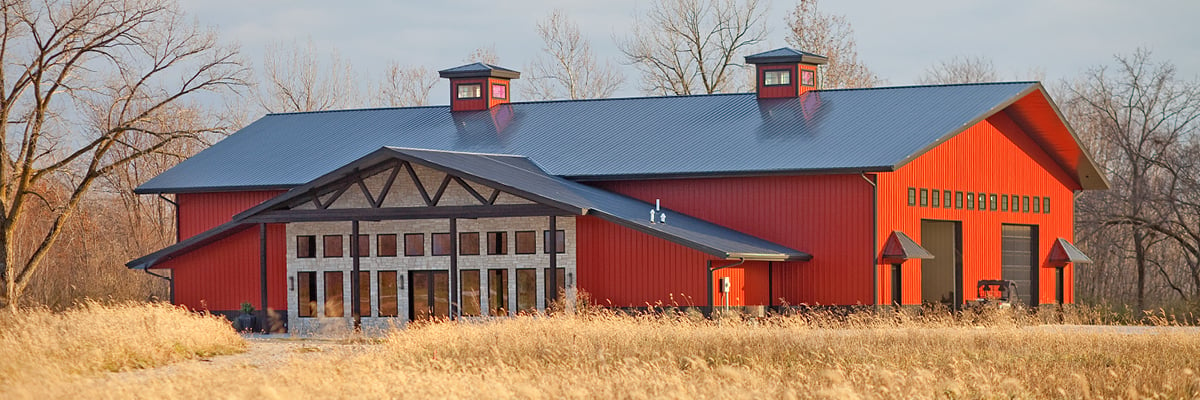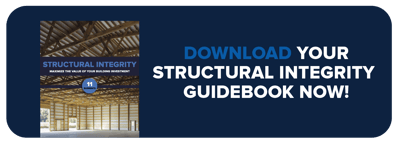What is Pole Barn Wind Load & Why is it Important?
Angie joined FBi Buildings in 2012 and is now the Director of Marketing. She's an avid reader and enjoys outdoor leisure and cheering on her two daughters at their sporting events.
As an experienced post frame builder, we know firsthand that the weather is unpredictable and uncontrollable.
One day, our construction crews are erecting pole barns in the brutal chill. The next day, it’s sunny with temperatures in the mid-50s. Not to mention, the wind is a constant force in the Midwest.
Eventually, you become accustomed to the abnormal weather patterns.
Picture this; you lock up your well-maintained farm shop after calling it quits to a long workday. As you relax in the recliner, the television meteorologist predicts strong and prevailing winds.
But, you’re not overly concerned. Everything is safely tucked away inside your post frame building.
What is Pole Barn Wind Load?
The term “wind load” refers to the internal and external wind pressure placed on a structure, which is measured in pounds per square foot (psf). Engineers use wind loads to determine which building materials will withstand Mother Nature’s curveballs.
The design load is based on wind speed and building codes obtained from the American Society of Civil Engineers Standard (ASCE 7-10). This publication helps engineers determine load requirements essential to their practice.
Later that night, the wind howls and keeps you from falling into a peaceful slumber. You can’t help but toss and turn. Next thing you know, the alarm clock is ringing obnoxiously.
After breakfast, you make your way outside for another day of honest work. Instantly, you notice the significant pole barn damage. No, your tired eyes aren’t playing tricks on you. We can only imagine your initial surprise (and frustration) to the overnight destruction.
High winds are inevitable. So, how can you avoid (albeit not 100 percent) future wind damage?
In this article, we discuss the importance of calculating your pole barn’s wind load to withstand gale-force weather.
How Does Wind Load Affect the Structural Integrity of Your Pole Barn?
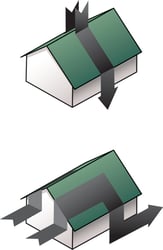
Structural integrity refers to a pole barn’s ability to withstand anticipated loads without breaking. Any post frame building, regardless of size and location, must be designed to resist vertical and lateral loads carefully.
First, vertical loads act in the up-and-down direction. Popular applications of vertical loads include:
- Lofts
- Deck systems
- Second stories
- Snow on the roof
- The weight of the building itself
Second, lateral loads act in a direction parallel to the ground (e.g., earthquakes and high winds). These forces can work in any direction. Therefore, the pole barn must be designed to resist loads, both parallel and perpendicular to any wall.
All structural loads must be able to pass from the areas in which the load is applied. This transfer of forces through the post frame structure is called the load path. A continuous load path transfers all vertical and lateral loads from one building component to another until they reach the ground.
If the load path flows continuously without interruption, there will be no structural damage. However, one break in the course can cause damage.
To avoid “weak links” caused by strong gales, experienced engineers calculate wind loads for specific building projects.
The term “wind load” refers to the internal and external wind pressure placed on a structure, which is measured in pounds per square foot (psf). Engineers use wind loads to determine which building materials will withstand Mother Nature’s curveballs.
There are three types of wind force, all of which have adverse structural effects on your post frame building:
- Shear Load: Horizontal forces that cause racking of the walls (i.e., tilting).
- Uplift Load: Wind flow under (or over) a roof that pushes (or pulls) upward.
- Lateral Load: Horizontal pressure on the walls that could make a pole barn slide off the foundation or overturn.
The design load is based on wind speed and building codes obtained from the American Society of Civil Engineers Standard (ASCE 7-10). This publication helps engineers determine load requirements essential to their practice.
What Factors Are Used to Calculate the Wind Load for Your Pole Barn?
Engineers account for the following influential factors when calculating your post frame building’s wind load. Each component plays a critical role in building design.
1) Basic Wind Speed
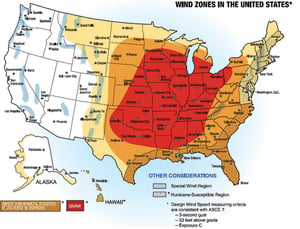
Basic wind speed is measured at 33 feet above grade (flat, open terrain) with a 3-second peak gust. Most of the U.S. has a basic wind speed (peak gust) of 105 mph. Undoubtedly, coastal regions have a much higher rate.
As the basic wind speed increases, the pressure intensifies exponentially (per the formulas established in the ASCE 7-10). Please note that the basic wind speed doesn’t guarantee your building will withstand the reported velocities.
Engineering jargon can be intimidating, so we provided a relatable illustration.
You’re driving down the interstate at 60 mph (recommended speed for optimal fuel efficiency). The speedometer hits 70 mph as you pass a semi.
Let’s do the math. That’s a 16 percent increase in speed (70 divided by 60) and a 36 percent increase in pressure (70² divided by 60²). Again, the force increases exponentially as your car gains speed.
The same principle can explain the significant pole barn damage occurring at 80 mph versus 60 mph gusts.
2) Exposure
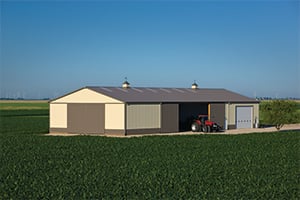
Next, the characteristics of the building location will greatly influence the wind load. How would you describe the surrounding landscape?
Engineers use the following exposure classifications to categorize your site (per ASCE 7-10):
- Surface Roughness B: Urban and suburban neighborhoods, wooded areas, or other terrains with numerous closely spaced obstructions having the size of single-family dwellings or larger.
- Surface Roughness C: Open terrain with scattered obstructions having heights less than 30 feet (e.g., countrysides and grasslands).
- Surface Roughness D: Flat, unobstructed areas and water surfaces (e.g., coastal wetlands, salt pans, and unbroken ice).
The smoother the terrain, the greater the wind pressure. Pole barns located in flat, unobstructed areas (D) have a higher wind load than those surrounded by other structures or woodland (B).
3) Topography
Once the exposure is determined, engineers have to account for the wind force within that specific category. Abrupt changes in topography (e.g., isolated hills and ridges) increase wind speed.
For example, your horse barn will have a higher wind load sitting on top of sloped terrain. Why? Because the hill forces the wind to speed up and over your structure. However, the natural ventilation is unmatched; thus, improving the indoor air quality for you and your animals.
4) Building Height
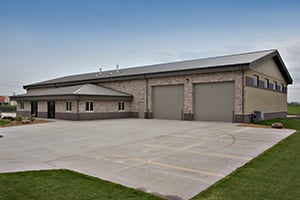 Pole barn height is subjective and depends on the intended use.
Pole barn height is subjective and depends on the intended use.
For instance, farmers prefer taller storage buildings to accommodate large doors and heavy machinery. It's convenient to store and move large implements (e.g., combines and sprayers) under one roof.
Similarly, warehouses have higher ceilings for easier access to assembly lines, equipment, deliveries, and trucks.
Furthermore, pole barn construction has become a popular housing option. Post frame homes can be one- or two-story depending on the homeowners’ needs.
Please note that wind speed increases with height above ground. Consequently, taller pole barns are exposed to a greater force.
5) Building Shape
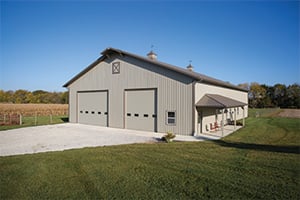
Also, the building shape influences the pressure coefficients and applied loads.
Due to building aerodynamics, the highest uplift loads occur at roof corners. The roof perimeter has a somewhat lower load, followed by the inner roof areas (field) and exterior walls.
Please note that some building features (e.g., lean-tos and porches) may affect the pressure coefficients. These irregularities cause localized turbulence; thus, increasing wind speed. Proper attachment is critical.
Altogether, the building envelope loads are transferred to the structural system until it reaches the foundation and ground.
To avoid damage, we recommend using uplift anchors. This building component is rigidly attached near the base of an embedded column. It significantly increases the force required to pull said column out of the ground.
6) Gaps & Leaks
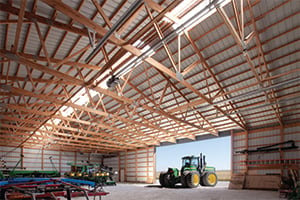 Lastly, gaps and leaks around doors, windows, and connections play a significant role in air movement. Wind force can cause an increase or decrease in pressurization.
Lastly, gaps and leaks around doors, windows, and connections play a significant role in air movement. Wind force can cause an increase or decrease in pressurization.
Let’s picture an enclosed post frame building with four walls. It’s a breezy day, so you decide to let in some fresh air. By opening the sliding doors, the pole barn is no longer enclosed.
Consequently, wind can rush through the large opening and pressurize the building interior. Therefore, the loads (internal pressures) are 3x greater.
Keeping doors and windows closed during high winds is critical. Why? Because openings in the building envelope allow for adverse pressures. Build-up can cause uplifting and structural damage.
ASCE 7-10 provides a procedure to assess the effect of internal pressure on wall and roof loads, as well as coefficients used in calculations.
Are You Ready to Take the Next Step with Your Post Frame Building?
Wind load is an essential aspect of designing and building a new pole barn. Overall, the actual effects of wind pressure depend on the floor plan, construction techniques, and surrounding terrain.
As a post frame builder with 60+ years of experience, we want our customers to make an informed buying decision. Often, structural issues (like wind loads) are overlooked. It’s not exactly the first topic that comes to mind when choosing a quality post frame builder.
For more talking points, you can download our FREE “Structural Integrity in Post Frame Construction” e-book. In the end, you’ll get the dream pole barn you’ve worked hard for and enjoy it well into the future.
Additional Resources:
Wind Safety of the Building Envelope by Whole Building Design Guide
Minimum Design Loads for Buildings and Other Structures by American Society of Civil Engineers Standard (ASCE)
Do you have more questions about pole barn wind loads that are not covered in this article? If you need help designing and planning, please contact FBi Buildings at 800.552.2981 or click here to email us. If you are ready to get a price, click here to request a quote and a member of our customer engagement team will help you determine the next steps of your project.
